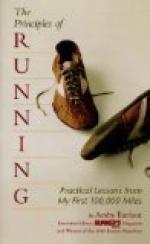The field is flat, but the path runs downhill. Consequently we soon find ourselves tramping along below the ground-level, with a stout parapet of clay on either side of us. Overhead there is nothing—nothing but the blue sky, with the larks singing, quite regardless of the War.
“Communication trench,” explains the guide.
We tramp along this sunken lane for the best part of a mile. It winds a good deal. Every hundred yards or so comes a great promontory of sandbags, necessitating four right-angle turns. Once we pass under the shadow of trees, and apple-blossom flutters down upon our upturned faces. We are walking through an orchard. Despite the efforts of ten million armed men, brown old Mother Earth has made it plain that seedtime and harvest shall still prevail.
Now we are crossing a stream, which cuts the trench at right angles. The stream is spanned by a structure of planks—labelled, it is hardly necessary to say, LONDON BRIDGE. The side-street, so to speak, by which the stream runs away, is called JOCK’S JOY. We ask why?
“It’s the place where the Highlanders wash their knees,” is the explanation.
Presently we arrive at PICCADILLY CIRCUS, a muddy excavation in the earth, from which several passages branch. These thoroughfares are not all labelled with strict regard for London geography. We note THE HAYMARKET, also PICCADILLY; but ARTILLERY LANE seems out of place, somehow. On the site, too, of the Criterion, we observe a subterranean cavern containing three recumbent figures, snoring lustily. This bears the sign CYCLISTS’ REST.
We, however, take the turning marked SHAFTESBURY AVENUE, and after passing (quite wrongly, don’t you think?) through TRAFALGAR SQUARE—six feet by eight—find ourselves in the actual firing trench.
It is an unexpectedly spacious place. We, who have spent the winter constructing slits in the ground two feet wide, feel quite lost in this roomy thoroughfare. For a thoroughfare it is, with little toy houses on either side. They are hewn out of the solid earth, lined with planks, painted, furnished, and decorated. These are, so to speak, permanent trenches, which have been occupied for more than six months.
Observe this eligible residence on your left. It has a little door, nearly six feet high, and a real glass window, with a little curtain. Inside, there is a bunk, six feet long, together with an ingenious folding washhand-stand, of the nautical variety, and a flap-table. The walls, which are painted pale green, are decorated with elegant extracts from the “Sketch” and “La Vie Parisienne.” Outside, the name of the villa is painted up. It is in Welsh—that notorious railway station in Anglesey which runs to thirty-three syllables or so—and extends from one end of the facade to the other. A small placard announces that Hawkers, Organs, and Street-cries are prohibited.
“This is my shanty,” explains a machine-gun officer standing by. “It was built by a Welsh Fusilier, who has since moved on. He was here all winter, and made everything himself, including the washhand-stand. Some carpenter—what? of course I am not here continuously. We have six days in the trenches and six out; so I take turns with a man in the Midland Mudcrushers, who take turns with us. Come in and have some tea.”




